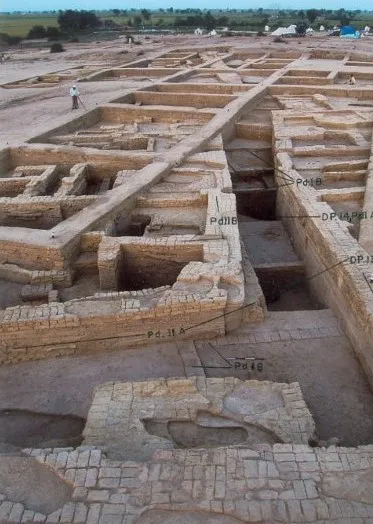Bhirrana, also spelt as Bhirdana and Birhana, is an archaeological site located in the Indian state of Haryana. It has gained prominence for being one of the oldest pre-Harappan sites, where evidence of continuous settlement can be traced back to before the rise of the Indus Valley Civilization. Excavations at Bhirrana have revealed a pre-Harappan culture dating back to as early as 7570-6200 BCE. The site showcases early evidence of farming and pastoralist activities in the region, providing crucial insights into the prehistoric era of the Indian subcontinent.
Get your dose of History via Email
Historical Background of Bhirrana
The discovery of Bhirrana was a milestone in understanding the pre-Harappan culture in India. Archaeologists stumbled upon this site in 1973, but it was not until 2003-2004 that major excavations took place under the guidance of L.S. Rao. The Archaeological Survey of India spearheaded these efforts, uncovering a sequence of cultural deposits from the pre-Harappan and Harappan periods. Bhirrana’s builders were skilled in town planning, showcasing a high level of sophistication for their time.
Over time, Bhirrana has seen various groups inhabit its lands. The site’s strategic location near the now extinct Sarasvati River made it an ideal settlement. This river’s existence is often intertwined with the Vedic texts, adding a layer of historical significance. Bhirrana’s inhabitants thrived on agriculture, bolstered by the fertile plains of the river. The site also provides evidence of a transition from the pre-Harappan to the mature Harappan phase, indicating a long period of occupation.
While Bhirrana did not witness any known historical battles or events, its importance lies in its continuous human habitation. The site offers a window into the daily lives of its ancient inhabitants. It reveals their advancements in craft, trade, and societal structures. Bhirrana’s endurance through various cultural phases makes it a key site for understanding the evolution of civilization in the Indian subcontinent.
The people who built Bhirrana were part of a larger cultural milieu that eventually culminated in the Indus Valley Civilization. Their architectural practices, pottery, and other artifacts suggest a community well-versed in the arts of living and survival. The site’s longevity indicates a stable and prosperous society that managed to sustain itself over millennia.
Later habitation at Bhirrana is evident from the material culture that succeeded the Harappan phase. The site shows signs of reoccupation in the medieval period, although these layers are not as well-studied as the pre-Harappan and Harappan ones. Bhirrana’s historical importance is further cemented by its contribution to the debate on the Sarasvati River and its role in the development of early Indian societies.
About Bhirrana
Bhirrana’s archaeological significance is highlighted by its well-preserved structures and artifacts. The site consists of a series of mounds that reveal a continuous sequence of settlements. Excavations have unearthed mud-brick houses, granaries, and fortifications, indicating a well-organized community. The use of baked bricks in later periods suggests advancements in construction techniques.
The materials used for construction at Bhirrana include mud bricks and baked bricks, with the latter being a hallmark of the mature Harappan phase. The site’s layout includes streets laid out in a grid pattern, drainage systems, and multi-roomed houses, reflecting an understanding of urban planning. The presence of granaries points to an economy based on agriculture and storage.
Architectural highlights from Bhirrana include remnants of a massive fortification wall that once protected the settlement. The wall’s construction technique, using mud bricks, is consistent with other pre-Harappan sites. The discovery of various artifacts such as pottery, tools, and ornaments provides a glimpse into the material culture of the inhabitants.
The methods of construction at Bhirrana evolved over time, with the initial phases using simple mud-brick techniques and the later phases incorporating more durable baked bricks. This transition is indicative of technological progress and increased trade with other regions, which may have introduced new building methods.
Overall, Bhirrana’s architectural and material remains are a testament to the ingenuity of its builders. The site’s preservation allows archaeologists to reconstruct the lifestyle and culture of a civilization that existed thousands of years ago, bridging the gap between the pre-Harappan and Harappan periods.
Theories and Interpretations
Several theories have emerged regarding Bhirrana’s role and significance in the pre-Harappan context. One theory suggests that Bhirrana was a major agricultural center, given the evidence of granaries and advanced farming tools. The proximity to the Sarasvati River would have provided the necessary resources for large-scale agriculture.
Another theory posits that Bhirrana played a crucial role in trade, connecting various regions of the Indus Valley. The discovery of seals and weights implies a system of trade and commerce. The variety of artifacts found at the site indicates interactions with distant cultures.
Mysteries surround Bhirrana, particularly regarding the script found on some artifacts. The undeciphered symbols raise questions about the language and communication methods of its inhabitants. Scholars continue to debate whether these symbols represent a form of writing or are merely pictorial representations.
Interpretations of Bhirrana’s material culture have had to rely on comparisons with other Indus Valley sites. The similarities in pottery styles and motifs have helped archaeologists piece together the cultural and chronological framework of the region. However, the absence of written records means that much of Bhirrana’s history is reconstructed from material remains.
Dating of Bhirrana has been carried out using various methods, including radiocarbon dating and thermoluminescence. These techniques have helped establish the timeline of settlement at the site, making Bhirrana one of the oldest known Harappan sites. The accuracy of these dating methods is crucial for understanding the broader narrative of the Indus Valley Civilization’s development.
At a glance
Country: India
Civilization: Pre-Harappan and Harappan
Age: 7570-6200 BCE (Pre-Harappan), Mature Harappan phase (2600-1900 BCE)
Conclusion and Sources
Reputable sources used in the creation of this article include:
- Wikipedia: https://en.wikipedia.org/wiki/Bhirrana
- World History Encyclopedia: https://www.worldhistory.org/Indus_Valley_Civilization/
- Archaeological Survey of India: http://asi.nic.in/
- UNESCO World Heritage Centre: https://whc.unesco.org/

